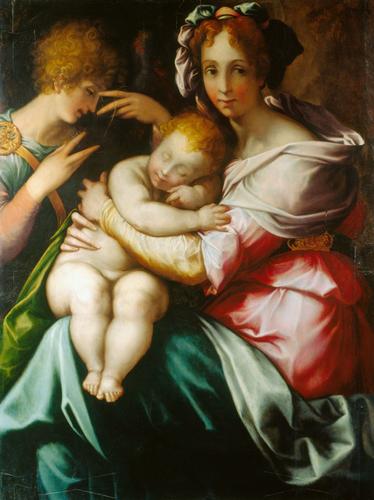The Virgin and Child with an Angel c. 1538-40
Oil on panel | 112.2 x 84.5 cm (support, canvas/panel/stretcher external) | RCIN 405778
-
This painting exemplifies the combination of realism, artificiality and powerful elegance typical of Salviati’s works. The Virgin looks away from the sleeping Christ Child, while an angel gazes down at him through a transparent veil, just visible between his fingers. The motif is unusual and may be a reference to the liturgical cloth that veiled statues and pictures during Passiontide and covered the hands of the officiating priest at High Mass. Such a transparent cloth is often draped over the body of the Christ Child, who instead is seen here nude. Perhaps the angel foresees the future Passion of Christ, whose sleeping posture reminds us of his death and entombment, although the expression of both the angel and the Virgin are of reverence rather than mourning.
In the nineteenth century it was thought to have been painted by Lorenzo Sabatini or Sebastiano del Piombo. Maso da San Friano and Taddeo Zuccaro were also suggested, until the attribution to Salviati was made in 1962. Another version of this painting, with a landscape behind the Virgin, was recently acquired by the National Gallery of Canada. A third version, probably a copy of the Ottawa painting because it has a landscape in the background, is in the Palazzo Ducale at Urbino. Detailed technical examination of the Royal Collection and Ottawa versions reveals that the panel size and preparation are identical, which suggests that they were produced in the same studio and at the same time. Technical examination also suggests that they are both by the hand of Salviati. This painting has many effects which are the opposite of the mechanical labour of the copyist: the angel’s brooch and the clasp on the Virgin’s waist are painted ‘wet-in-wet’, with no underdrawing; there are distinctive little hatched strokes, in the red and blue of the angel’s wing, on the top of the Virgin’s turban, around the drapery on her shoulders, and on the fingers of Christ. The evidence of the underdrawing and tracings of the compositions suggests that Salviati began this painting first, using a cartoon but changing the design as it progressed. The same cartoon and this finished painting then became the basis for the Ottawa version.
Despite these two works being autograph and identical in date, there are striking differences between them. There are several compositional differences. This painting is broadly painted, more solid, less finished and less refined, than the Ottawa version, which suggests a later date. The combining of hot and cool colours and the hatched technique recalls Rosso Fiorentino’s work. The spiralling curls and profile view of the angel resemble the angels in the Pietà with Four Angels (Museum of Fine Arts, Boston). The composition and angel have been compared to the Madonna of the Parrot of c. 1543 (Prado), but the figures are slimmer in this later painting. The painterly technique in this version may reflect works Salviati saw on a trip north. Such comparisons, if we are right in believing that they were produced at the same time, suggest a date of 1538-40 for both works.
Catalogue entry adapted from The Art of Italy in the Royal Collection: Renaissance and Baroque, London, 2007Provenance
First recorded as Sabbatini in the Queen's Dining Room at Kensington Palace in a hand-written annotation to a printed catalogue of 1778; measured and fully described in this same location in 1818 (no 185)
-
Creator(s)
-
Medium and techniques
Oil on panel
Measurements
112.2 x 84.5 cm (support, canvas/panel/stretcher external)
148.0 x 122.0 x 12.0 cm (frame, external)
Other number(s)
Alternative title(s)
Holy Family, previously entitled
The Virgin and sleeping Saviour, previously entitled










